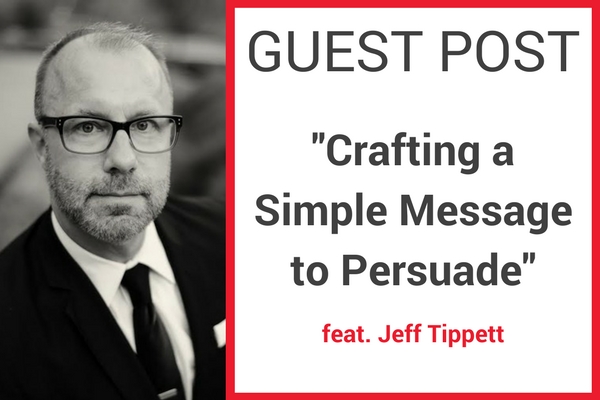Guest Blog | Crafting a Simple Message to Persuade
August 24, 2017 Welcome to another Thoughtful Thursday! Each week, Thursday features a new guest blogger to the site. I’m choosing FANtastic bloggers who know the ins and outs of sales and marketing. If you are interested in being a guest blogger, please drop us an email. So grab a cup of coffee and dive in! You’re sure to learn something new.
Welcome to another Thoughtful Thursday! Each week, Thursday features a new guest blogger to the site. I’m choosing FANtastic bloggers who know the ins and outs of sales and marketing. If you are interested in being a guest blogger, please drop us an email. So grab a cup of coffee and dive in! You’re sure to learn something new.
(If You Lose Them, You Can’t Persuade Them)
“If you can’t explain something simply, you don’t know enough about it.” – Albert Einstein
Whether conveying a policy position, business concepts or the attributes of a product – whatever it is that you need to share in order to pull your audience along – no one will jump on board if they don’t clearly grasp your message. Almost all effective, persuasive messaging has one common core component: simplicity.
You have seconds to capture your audience. If they can’t quickly – as in seconds – grasp your core message, you’re sure to lose them.
Most people don’t read; they scan. And they gravitate toward stylistic devices like bullet points that offer simple content and lots of white space. That’s how we grab people these days. You need to craft simple, impactful messaging.
The message is rarely simple; it is, in most cases, multifaceted. And you probably know the issue at its deepest and most complex level. But when it comes to persuading others, you must – at least at the outset – keep it simple. Here are some suggestions to help with that.
1. Debrief Yourself
When I set about to craft a message, ideas begin to bounce around my head like ping-pong balls. I see all the dimensions, curves, angles, various components. I’ve now got to get all that out of my head.
So get it all out, all those concepts. Explore how to best do so. We all have different ways of working. Find the way that’s right for you.
Here are a few tips to try:
- Write everything on a whiteboard
- Sit with a friend; say it all, record it
- Talk into your iPhone
- Type into a document
- Take a pad of paper and start writing
The objective is to get all the concepts floating around in my head into some physical form. This brings clarity. What you now have are pieces of a puzzle. Move them around. This fits here, that fits there. That piece over there? You’re not yet quite sure where it fits, but sense that it fits somewhere. Put it aside; save it for later.
Now focus on what’s most immediately relevant and hone it down to its essence. There may multiple methods of getting it all out there that work well for you. Investigate. Explore. Try out a few. I sometimes use a combination. There’s no right way, no one-size-fits-all approach.
Once it’s all out there, it’s time to begin the process of crafting that simple, persuasive message. This content will be a living message; it’ll continue to evolve over time. Don’t aim for perfection. Your goal is to refine and improve the messaging as you walk through these steps.
2. Ask yourself; “What problem does this solve?”
Every human being has three fundamental areas of concern: money, relationships and health. Given all of life’s complexities, most all problems can be tossed into one of these buckets. Offering solutions to issues in one of those categories is a great way to motivate people to take action.
The common practice in marketing a product or service is to stress its selling points. But that’s not often the most effective motivation. If you want people to care, show them how what you’re offering will solve a real problem they face.
Start with the problem/solution model: My audience has a problem and I can solve it. If nothing immediately stands out, this would be a great time to reread all your content and identify the problems that you can potentially solve. People will pay attention if you’re solving a real problem for them.
First you need to articulate what problem you’ve arrived to solve. So can you, in one succinct sentence, explain what that is? Look at these two sentences. What’s different about them?
- My new book, Pixels Are the New Ink, gives advice for building your social profiles.
- My new book, Pixels Are the New Ink, teaches thought leaders like you how to make money sharing information already in your head – online.
While the first sentence is true, it isn’t persuasive. The second sentence, on the other hand, assumes that my reader would like to make more money (and that’s probably a fair assumption of most people) and offers the opportunity to do so.
Do you think I have their attention? Likely so. Time to move on to the next step.
3. Ask what is crucial. Strike everything else.
“The ability to simplify means to eliminate the unnecessary so the necessary may speak.”
– Hans Hoffman
I vividly remember the first paper I submitted in graduate school. I was rather proud of it, actually. I put a lot of thought and work into the paper. I was quite certain it was probably the best in the class.
But my English professor didn’t see my work in exactly the same light. My masterpiece was returned to me, bleeding a slow death of red ink, with a note asking me to speak with her.
How could this be? My undergraduate English professors loved my work. But, in this case, I was called out for verbosity. In my quest to appear smart, I’d loaded every paragraph with every concept within the universe. And as a result, I failed. Miserably.
As you craft your message, read with a critical eye. You’ll likely immediately begin to see what needs to be trimmed. Focus on eliminating any and all unnecessary elements.
Let’s go ahead and get this out there now: Most likely your users won’t care as much as you do. So give them only what’s necessary.
Take out your red pen. Start striking through non-crucial elements. Ask yourself what details really don’t matter. Everything else must go!
But what I mean by that is that it must go for now. There’s probably value in that content, just not quite yet – not here in the core. File it away for now. If you start off too deep, you’re going to lose your audience.
And the final step …
4. Remove all internal (or generally unknown) jargon
We often communicate with insider language that isolates those who aren’t “in the know.” Perhaps it makes us feel smarter – a member of some inner circle – to use esoteric terms. But anytime there’s an inner circle, there are, by definition, people left outside.
Be careful not to unnecessarily alienate the people you’re actually trying to persuade. If the internal jargon isn’t necessary, strike it. If you use an acronym, define it. Then stick with it.
Bottom line: Don’t create barriers with language. When it’s time to introduce denser language, introduce it with some context.
“Simplicity is an exact medium between too little and too much.” – Sir Joshua Reynolds
Here’s what we learned: less is more. Focus only on what is necessary and important. Everything can be saved for later.
Meet the Author

Known for his enthusiastic style and peaceful hustle, Jeff Tippett is an award winning communications specialist with clients in his home base of Raleigh, North Carolina and all over the globe.
Jeff’s passion for exploring the unknown and drive to help others leadsd him to speak, write, and produce webinars and online courses for the purpose of helping people such as business leaders, advocates, and political figures find their next new thing in their journey to build influence and grow business.
Jeff is the founder of Targeted Persuasion (a public affairs + communications firm) and the Principal for Total Management (a speakers’ bureau representing an elite group of the world’s most exciting speakers).
Outside of work, Jeff is a father to three kids and can also be found working out in the gym, training for half marathons, or playing the piano at area venues.
Related Posts:
Categorised in: FANtastic Selling Tips, Guest Blogs, Thoughtful Thursdays








